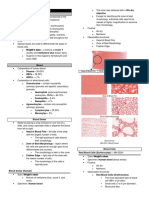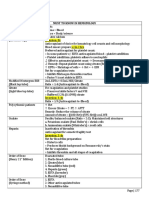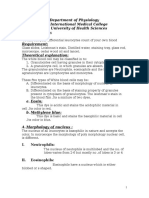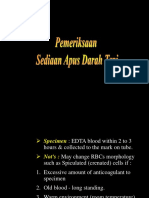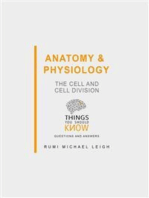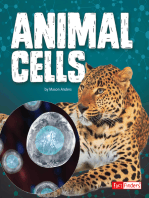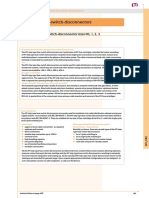Lab Report
Uploaded by
Do TanLab Report
Uploaded by
Do TanTitle: Leukocyte observation Date: 20/04/2011
Name: Do Le Tan Lab Partners:
Introduction: In the nature, almost the cell in side is transparent and need to be dyed to observe. Cytochemistry is the method used for the chemical nature of the cell, and it will be used to observer many kind of cells in our blood such as: Red Blood Cells : Erythrocytes,or red blood cells,are biconcave disks.They transport the oxygen used in aerobic respiration and carry away some carbon dioxide wastes.When oxygen diffuses into blood,it binds with hemoglobin,an ironcontaining pigment that gives red blood cells their colour. White Blood Cells Leucocytes,or white blood cells,function in daily housekeeping or defense.They differ in size,nuclear shape and staining traits.There are five types: neutrophils, eosinophils, basophils, monocytes and lymphocytes. In this experiment, only monocytes and lymphocyte are observed Monocytes: are large mononuclear cells.This nucleus is quite large,sometimes round,but more usually irregular.The monocytes differ from lymphocytes in that they can spread on a glass surface. Lymphocytes: nucleus is generally centrally placed and round but it may be oval or slightly concave.The cytoplasm is basophilic and shows mitochondria,together with a few azurophile granulations and a centrosome which is particularly clearly defined. Materials: 1. Drops of animal blood (except poultry) 2. Slides 3. Giemsa stain solution 4. Ethanol 5. Water Methods: 1. Smear specimen preparation. 2. Drop a small drop of blood on the slide and spread it lightly and rapidly. 3. Air dry. 4. Fix slide in ethanol for 5 minutes. 5. Air dry. 6. Place Giemsa stains solution for 2 minutes; try to shake it gently during incubation. 7. Rinse slide with water. 8. Air dry. Data:
Image 1: There is 1 lymphocyte on the right which has pink color and has the nucleus inside fill nearly all the cell. There is 1 monocyte on the left which has also pink color by giemsa but the cell has nucleus inside does not fill cell
Image 2: There is another image of monocyte which is the pink one Discussion: The blood smear should be as thin as possible to be able to observe cells clearly and not to have too much of them.
Tap water will not contaminate the blood because before rinsing with water it is fixed. By fixation treatment, the general morphology and internal structures are preserved. Write the name of the experiment on the slide after dropping blood and spread it to avoid negligence Control slide is also used in this experiment. It is better to set paper under the slide when place giemsa solution to the slide Conclusion:
You might also like
- (Transes) Human Histology - 12 Peripheral BloodNo ratings yet(Transes) Human Histology - 12 Peripheral Blood5 pages
- Ext - Textbook of Practical Physiology (G.K Pal and Pravati Pal)100% (1)Ext - Textbook of Practical Physiology (G.K Pal and Pravati Pal)7 pages
- Smear Preparation and Leukocyte Differential Count: John Mark Mondejar, RMTNo ratings yetSmear Preparation and Leukocyte Differential Count: John Mark Mondejar, RMT35 pages
- Differential Leukocyte Count:: The Types of LeukocytesNo ratings yetDifferential Leukocyte Count:: The Types of Leukocytes4 pages
- Blood Hemin Crystal, Blood Leucocyte Count, Blood GroupingNo ratings yetBlood Hemin Crystal, Blood Leucocyte Count, Blood Grouping7 pages
- PAG1.2 Student The Examination and Drawing of Cells Observed in Blood Smears - v0.4No ratings yetPAG1.2 Student The Examination and Drawing of Cells Observed in Blood Smears - v0.43 pages
- Immune_Lab_manual_ABCT2329_2018_version_1(1) - 複本No ratings yetImmune_Lab_manual_ABCT2329_2018_version_1(1) - 複本6 pages
- Differential Leucocyte Count (Differential Blood Cell Count) - Class Rep EditNo ratings yetDifferential Leucocyte Count (Differential Blood Cell Count) - Class Rep Edit5 pages
- Observation of Red Blood Cells and Elements of Peripheral BloodNo ratings yetObservation of Red Blood Cells and Elements of Peripheral Blood13 pages
- LABORATORY WORK 2 (WBCs and Platelate) 1 семестрNo ratings yetLABORATORY WORK 2 (WBCs and Platelate) 1 семестр8 pages
- Heamatology Assignment-Adesanmi Ademola - 221506462No ratings yetHeamatology Assignment-Adesanmi Ademola - 2215064627 pages
- APznzaZu0NBVvnFa_R5DKIeNaUZm8z4y4gZocMrxv7Ed0AUOKVtNaLZkqE-PBTVPs6qGbvAW4gbyNRZbNGjMpCoMde-9k4x0U9JkWWCLLd...TzLQB_9SRd8k4_5QYWL-t6_BQv90dGT0u8vR6a0inKqGzXXeU7uwqOotoaxVUlQtTY-Cj5q6WAXvWBGEXtrTZFnPE_KdXOkztLgLMLuP8G6650eW9hRta2Tlo=No ratings yetAPznzaZu0NBVvnFa_R5DKIeNaUZm8z4y4gZocMrxv7Ed0AUOKVtNaLZkqE-PBTVPs6qGbvAW4gbyNRZbNGjMpCoMde-9k4x0U9JkWWCLLd...TzLQB_9SRd8k4_5QYWL-t6_BQv90dGT0u8vR6a0inKqGzXXeU7uwqOotoaxVUlQtTY-Cj5q6WAXvWBGEXtrTZFnPE_KdXOkztLgLMLuP8G6650eW9hRta2Tlo=5 pages
- 1 ULTRASTRUCTURE AND FUNCTIONS OF ER and MitochondriaNo ratings yet1 ULTRASTRUCTURE AND FUNCTIONS OF ER and Mitochondria32 pages
- Human Physiology Lab Report 1 - Group 26No ratings yetHuman Physiology Lab Report 1 - Group 2614 pages
- IMMUNOLOGY AND ENZYMOLOGY (E3771AI) PRACTICAL MANUALNo ratings yetIMMUNOLOGY AND ENZYMOLOGY (E3771AI) PRACTICAL MANUAL24 pages
- Results: The Blood Cells Are Circular in Shape and Are NormalNo ratings yetResults: The Blood Cells Are Circular in Shape and Are Normal2 pages
- Tp2 Observation of a Blood Slide Using Light MicroscopyNo ratings yetTp2 Observation of a Blood Slide Using Light Microscopy4 pages
- Anatomy and Physiology: The Cell and Cell Division: Things You Should Know (Questions and Answers)From EverandAnatomy and Physiology: The Cell and Cell Division: Things You Should Know (Questions and Answers)No ratings yet
- Seasonal Foods: Tota L Hea LTH Acceler AtorNo ratings yetSeasonal Foods: Tota L Hea LTH Acceler Ator3 pages
- NV Strip Type Fuse-Switch-Disconnector Sizes 00, 1, 2, 3No ratings yetNV Strip Type Fuse-Switch-Disconnector Sizes 00, 1, 2, 33 pages
- Review Test Submission: Exam 1: Blackboard at CCACNo ratings yetReview Test Submission: Exam 1: Blackboard at CCAC3 pages
- Grade 3 - Connect - Final Revision - First TermNo ratings yetGrade 3 - Connect - Final Revision - First Term9 pages
- Physical Fitness and Vegetarian Diets: Is There A Relation?: David C NiemanNo ratings yetPhysical Fitness and Vegetarian Diets: Is There A Relation?: David C Nieman6 pages
- Shower Tile - Over Tray Installation Guide Wet Area Solutions (Aust) Pty LTDNo ratings yetShower Tile - Over Tray Installation Guide Wet Area Solutions (Aust) Pty LTD4 pages
- Full Download Serious Cycling 2nd Edition Edmund R. Burke PDF DOCX100% (15)Full Download Serious Cycling 2nd Edition Edmund R. Burke PDF DOCX60 pages
- Beginning of The Dutch Delta Project. Engineers With The Delta Project Worked Together. TheyNo ratings yetBeginning of The Dutch Delta Project. Engineers With The Delta Project Worked Together. They2 pages
- Module 3: Sampling and Reconstruction Problem Set 3No ratings yetModule 3: Sampling and Reconstruction Problem Set 320 pages
- Phytoremediation - A Promising Approach For Pollution ManagementNo ratings yetPhytoremediation - A Promising Approach For Pollution Management7 pages
- Smallville - 2x09 - Dichotic - Dvdrip.enNo ratings yetSmallville - 2x09 - Dichotic - Dvdrip.en39 pages
- 5E - Lost Lands - The Blight - TB1 The Crooked Nail (LVL 1)100% (4)5E - Lost Lands - The Blight - TB1 The Crooked Nail (LVL 1)39 pages
